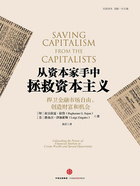
小结
人们一方面指责金融家们是无用的寄生虫,另一方面又害怕他们拥有的权势,在本章我们解释了为什么这两种看法并不矛盾。在现代经济中,金融渠道的畅通至关重要,如果金融体系缺乏发展,少数金融家就控制了有限的信贷资源。特别奇怪的是,金融家越是限制金融体系的发展,他们还越有权势。于是,他们只需要当好看门人,把大众挡在外面,让少数有钱和有关系的人能够在里面得到安全融资。金融家们是有权势的,但是他们的权势是一种拒绝别人的权势,而不是创造财富的权势,而且他们还“必然要制约、阻挠和破坏真正的经济自由”。资本主义的许多罪恶——例如,资本对劳动的统治,工业的过分集中,收入分配向资本所有人过分倾斜,穷人缺乏成功机会等——都可以部分地归罪于金融市场的不发达。
但是,在这种金融体系下,金融家个人其实并没有做错什么,他们只是在这个体制的约束之下按照理性的原则办事情。即便是《威尼斯商人》里令人生厌的夏洛克,他去索取抵押品也只不过是正常地履行合同。而如果法庭阻止他履行合同,信贷资源将会变得更加稀缺。
在另一方面,如果有了良好的制度基础,金融家们就可以突破抵押和关系的特权限制,让穷人能够得到信贷,他们自己也将成为进步的力量,而不再是保守的现状维护者。下一章我们将对此做详细的阐述。
[1] 汤姆·沃尔夫(Tom Wolfe),美国当代作家、记者,他的小说《虚荣的篝火》(The Bonfire of the Vanities)发表于1987年,故事以20世纪80年代纽约的投资热潮为背景,后来被改编为电影,中文片名为《夜都迷情》。——译者注
[2] 参见Tom Wolfe, The Bonfire of the Vanities (New York: Farrar, Straus and Giroux, 1987), 229, 转引自Daniel Fischel, Payback: The Conspiracy to Destroy Michael Milken and His Revolution (New York: Harper Business, 1995)。
[3] Louis D. Brandeis, Other People's Money (Washington, DC: National Home Library Foundation, 1933), 1.
[4] J. Stiglitz and A. Weiss, “Credit Rationing in Markets with Imperfect Information,” American Economic Review 71 (1981): 393-410.
[5] 有关抵押的研究,参见Yuk Shee Chan and Ajan V. Thakor, “Collateral and Competitive Equilibria with Moral Hazard and Private Information,” Journal of Finance 42 (1987): 345-364;D. Besanko and A. Thakor, “Collateral and Rationing: Sorting Equilibria in Monopolistic and Competitive Credit Markets,” International Economic Review 28 (1987):671-689。
[6] 其实,达成这笔交易需要夏洛克对那名商人怀有仇恨,否则他就不会真正去索取那一磅肉,那么追偿抵押品的威胁就不可信了。
[7] T. Jappelli, M. Pagano, and M.Bianco, “Courts and Banks: Effects of Judicial Enforcement of Credit Markets,” CEPR working paper no. 3347, April 2002. Similar studies include M. Chiuri and T. Jappelli, “Credit Market Imperfections and Home Ownership: A Comparative Study,” CEPR discussion paper no. 2717, 2001; D. Fabbri and Mario Padula, “Judicial Costs and Household Debt,”working paper, Center for Studies in Economics and Finance, University of Salerno, Italy, 2001; Lee Alston, “Farm Foreclosure Moratorium Legislation: A Lesson from the Past,” American Economic Review 74, no. 3 (1984): 445-458; and R. Gropp, J. Scholz, and M. White, “Personal Bankruptcy and Credit Supply and Demand,” Quarterly Journal of Economics 112 (1997): 217-251.
[8] Gropp, Scholz, and White, “Personal Bankruptcy and Credit Supply and Demand,” 217-251.
[9] Hernando de Soto, The Mystery of Capital: Why Capitalism Triumphs in the West and Fails Everywhere Else (New York: Basic Books, 2000).
[10] M. Petersen and R. Rajan, “The Benefits of Lending Relationships: Evidence from Small Business Data,” Journal of Finance 49 (1994): 3-37.
[11] Luigi Guiso and Luigi Zingales, “The Rise of Bank Relationships,” University of Chicago, WP, 1999.
[12] Naomi Lamoreaux, Insider Lending: Banks, Personal Connections and Economic Development in Industrial New England (Cambridge, U.K.: Cambridge University Press, 1994).
[13] R. G. Rajan, “Insiders and Outsiders: The Choice between Informed and Arm's Length Debt,” Journal of Finance 47 (1992): 1367-1400.
[14] 参见Pujo Committee report, 转引自Brandeis, Other People's Money, 31。
[15] E. J. Hobsbawm, The Age of Capital, 1848-1885 (New York: New American Library, 1979), 242.
[16] Harris Corporation, Business History Review, “Founding Dates of the 1994 Fortune 500 U.S. Companies,” spring 1996, 69-90.
[17] J. Fear, “German Capitalism,” in Creating Modern Capitalism: How Entrepreneurs, Companies, and Countries Triumphed in Three Industrial Revolutions, ed. T. McCraw (Cambridge, Mass.: Harvard University Press, 1997), 181.
[18] R. W. Fogel, The Fourth Great Awakening and the Future of Egalitarianism (Chicago: University of Chicago Press, 2000), 112, and the references there.
[19] T. McCraw, “American Capitalism,” in Creating Modern Capitalism, 320.
[20] A. Chandler, Scale and Scope: The Dynamics of Industrial Capitalism (Cambridge, Mass.: Belknap Press, 1990), 18.
[21] R. Chernow, Titan: The Life of John D. Rockefeller (New York: Random House, 1998), 226.
[22] Chandler, Scale and Scope, 25.
[23] Chernow, Titan, 288.
[24] Chandler, Scale and Scope, 25.
[25] Chernow, Titan, 265.
[26] David Blau, “A Time Series Analysis of Self-Employment in the United States,” Journal of Political Economy 95, no. 3 (1987): 445-468.
[27] 有关模型参见R. Rajan and L. Zingales, “The Firm as a Dedicated Hierarchy: A Theory of the Origins and Growth of Firms,” Quarterly Journal of Economics 116 (2001): 805-852。
[28] Chandler, Scale and Scope, 598.
[29] L. Stole and J. Zwiebel, “Organizational Design and Technology Choice under Intra-Firm Bargaining,” American Economic Review 86 (1996): 195-223, for a model of overstaffing by the owners to appropriate rents.
[30] 简单地说,垂直集中型企业使用多种激励措施,通过内部的竞争和官僚化的办事程序来降低业务对员工的依赖性,同时又利用晋升机会来避免他们过于懈怠。参见R. Rajan and L. Zingales, “The Firm as a Dedicated Hierarchy”。
[31] Claudia Goldin and Lawrence Katz, “The Returns to Skill in the United States across the Twentieth Century,” NBER working paper 7126, 1999.
[32] Dani Rodrik, “Democracies Pay Higher Wages,” NBER working paper 6364, 1998.